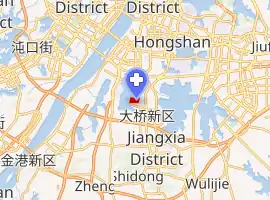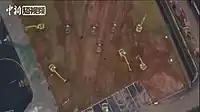Leishenshan Hospital
Leishenshan Hospital (Chinese: 雷神山医院; lit. 'Mount Thunder God Hospital') is an emergency specialty field hospital built in response to the COVID-19 pandemic.[3][4] The facility is located at No.3 Parking Lot of the Athletes Village in Jiangxia District, Wuhan, Hubei. Stage one of construction was completed on 6 February 2020, and the hospital opened on 8 February 2020. Along with the Huoshenshan Hospital, a further sixteen other temporary treatment facilities were set up for isolation and treatment of COVID-19 cases.[5] Leishenshan and Huoshenshan hospitals were closed and sealed on 15 April 2020, pending possible reopening in the event of a resurgence of cases.[5]
| Leishenshan Hospital | |||||||
|---|---|---|---|---|---|---|---|
.jpg.webp) | |||||||

| |||||||
| Geography | |||||||
| Location | Jiangxia District, Wuhan, Hubei, China | ||||||
| Coordinates | 30.432048°N 114.288276°E | ||||||
| Services | |||||||
| Beds | 1,600 (official)[1] 1,500 (operational)[2] | ||||||
| History | |||||||
| Opened | 8 February 2020 20 February 2020 (Fully opened) | ||||||
| Closed | 15 April 2020 | ||||||
| Links | |||||||
| Lists | Hospitals in China | ||||||
| Chinese name | |||||||
| Simplified Chinese | 雷神山医院 | ||||||
| Traditional Chinese | 雷神山醫院 | ||||||
| Literal meaning | Mount Thunder God Hospital | ||||||
| |||||||

.jpg.webp)
Etymology
The name "Leishen" (雷神; 'God of Thunder') refers to Leigong, a deity in Chinese folk religion who punishes both earthly mortals guilty of secret crimes and evil spirits who have used their knowledge of Taoism to harm human beings.[6][7]
The name "Lei" (雷; 'Thunder') is also related to the concept of wood (木) in wuxing (五行), wherein wood begets fire (木生火) and fire overcomes metal (火克金). In traditional Chinese medicine, the metal element (金) governs the lung (肺), so the name conveys the hope that the respiratory infection caused by SARS-CoV-2 will eventually be eliminated.[6][7]
History
At 3:30 p.m. on 25 January 2020, the Wuhan municipal government decided to establish an additional hospital named "Leishenshan Hospital" in response to the COVID-19 pandemic. The hospital was located at No.3 Parking Lot of the Athletes Village in Jiangxia District of Wuhan. On January 27, the National Development and Reform Commission announced the allocation of 300 million yuan to subsidize the construction of Huoshenshan Hospital and Leishenshan Hospital.[8] The same day, the State Grid Corporation of China announced to donate 60.28 million yuan worth of physical materials to the construction of the two hospitals.[9]
On 6 February 2020, the construction of the hospital was completed.[10] 2 days later on 8 February 2020, a total of 1,600 beds were delivered to the hospital.[11] On the same day, Vice Premier Sun Chunlan visited the building. She stressed that treatment should be carried out based on the priority of the severity of the patient's condition.[12] The first 30 patients were admitted to the hospital on the same day at 8:00 p.m.
As of 20 February 2020, the hospital had an operational capacity of 1500 beds.[2]
On 15 April 2020, it was 'retired' after treating 2,011 patients.[5] It currently remains on standby.[13]
Design
The hospital is a field hospital-based building with modular design.[14] It has 32 zones for patients, two of which are for those in critical condition and three for those with serious symptoms.[15]
References
- 雷神山医院病床增至1600张 ['Thunder Hill' Hospital's hospital beds increased to 1,600]. Beijing News. 2020-01-29. Archived from the original on 2020-01-29. Retrieved 2020-01-29.
- 雷神山医院已累计收治病人1961人,约半数已治愈出院 18 March 2020 "Thunder Mountain" Hospital has admitted 1961 patients, about half of them have been cured and discharged, accessed 19 April 2020 baijiahao.baidu.com
- 火神山、雷神山医院将于2月3日和2月6日收治病人 [Vulcan Hill and 'Thunder Hill' Hospital will treat patients on February 3 and February 6]. yicai.com. 2020-01-31.
- Umlauf, Jessica Wang, Ellie Zhu and Taylor (2020-02-03). "How China Built a Coronavirus Hospital in 10 Days". Wall Street Journal. ISSN 0099-9660. Retrieved 2020-02-05.
- Lu, Joanne (10 September 2020). "Whatever Happened To ... The Instant Hospitals Built For COVID-19 Patients In Wuhan?". NPR.
- Yang Baobao (27 January 2020). 田兆元:“雷神山”“火神山”两所医院的命名来自中国传统 [Two hospitals named "Thunder Mountain" and "Vulcan Mountain" come from Chinese tradition]. The Paper (in Chinese). Retrieved 28 January 2020.
- Liu Yuxin, ed. (26 January 2020). "Archived copy" 独家揭秘:"火神山"、"雷神山"名字怎么来的? [Exclusive Secret: How did the names "Vulcan Mountain" and "Thunder Mountain" come from?]. 163.com (in Chinese). Archived from the original on 26 January 2020. Retrieved 28 January 2020.CS1 maint: archived copy as title (link)
- Yue Qun; Li Juan; Xu Ningning (2020-01-27). "Archived copy" 国家发改委紧急下达中央预算内投资3亿元,支持湖北疫情应对 [National Development and Reform Commission urgently issues 300 million yuan in central budget to support Hubei response]. The Paper (in Chinese). Archived from the original on 2020-01-27. Retrieved 2020-01-28.CS1 maint: archived copy as title (link)
- Yang Yang (2020-01-27). "Archived copy" 国网:先期向鄂捐5000万元及6000万元电力实物资产 [State Grid: Donate 50 million yuan and 60 million yuan of electricity physical assets to Hubei in advance]. The Paper (in Chinese). Archived from the original on 2020-01-27. Retrieved 2020-01-28.CS1 maint: archived copy as title (link)
- Steinbuch, Yaron (6 February 2020). "China opens second new hospital for coronavirus patients". New York Post. Retrieved 8 February 2020.
- Mu, Xuequan (7 February 2020). "1,600 beds for Leishenshan Hospital to be delivered in Wuhan on Feb. 8". Xinhuanet. Retrieved 8 February 2020.
- "Vice premier stresses racing against time to treat patients". Xinhuanet. 8 February 2020. Retrieved 9 February 2020.
- Live Reporting, Edited by Hugo Bachega 6:19- China retires 'Thunder God Mountain' hospital 15 April 2020, www.bbc.co.uk, accessed 15 April 2020
- "Leishenshan Hospital in Wuhan uses modular design based on layout of field hospital". Xinhuanet. 8 February 2020. Retrieved 9 February 2020.
- Li, Yan (8 February 2020). "Leishenshan Hospital ready to receive patients". ECNS. Retrieved 8 February 2020.
External links
 Media related to Leishenshan Hospital at Wikimedia Commons
Media related to Leishenshan Hospital at Wikimedia Commons